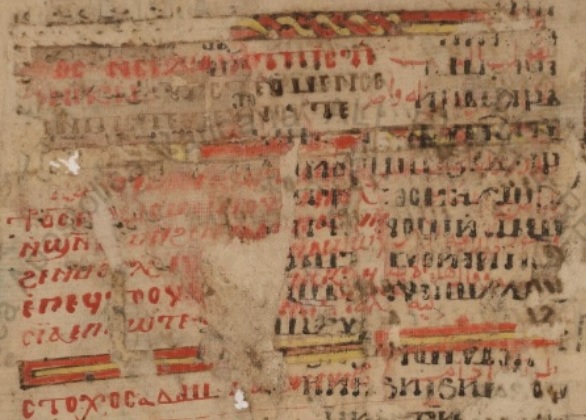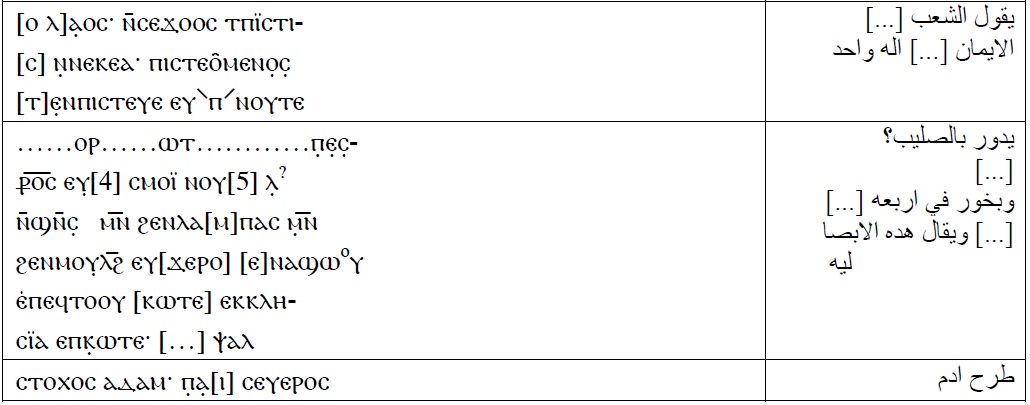The investigation of the Coptic Holy Week Lectionary in Egypt is the primary objective of the DFG project AT 193/2–1 “Digital Edition and Critical Evaluation of the Coptic Holy Week Lectionary” currently pursued at the Göttingen Academy of Sciences and Humanities of Lower Saxony. The on-site consultation of the manuscripts constituting the backbone of the project’s research is one of its milestones. During a 14-day visit of the Biblioteca Apostolica Vaticana, we were able to shed light on aspects up till then invisible on the digital reproductions of manuscript pages and to proceed to an autopsy of some non-digitized manuscripts. The Biblioteca Apostolica Vaticana is home to two of our main Sahidic–Arabic Holy Week lectionaries (included in the digital collection of the Vatican library) and to three of the Bohairic–Arabic Holy Week lectionaries (not yet digitized by the Vatican library) used by Burmester in his “Le Lectionnaire de la Semaine Sainte”.[1] Besides the activities mentioned above, the visit also allowed us to exclude the codex Vat.ar.15, a non-digitized Arabic codex wrongly assumed to be a Holy Week lectionary. My colleague Diliana Atanassova was also there for an on-site autopsy of all Sahidic liturgical typika kept in BAV within the framework of her DFG project AT 193/1–1 “The Hymns in the Coptic Liturgy of the White Monastery in Upper Egypt”.
The autopsy results concerning the manuscript sa 16L are presented in what follows. Part II (forthcoming) will be dedicated to some other manuscripts.
sa 16L, end of the 14th century [2]
Biblioteca Apostolica Vaticana, Borg. Copt. 109, cass. XXIII, fasc. 99
Bilingual Sahidic–Arabic Holy Week lectionary written on unwatermarked Egyptian brownish ‘two-layered’ paper,[3] with apparent laid lines and non-distinguishable chain marks, 189 surviving folios, page dimensions 36.5x26.5 cm, text coverage 25.5x19 cm, lines per page: 26–28 for the Sahidic text and 15–22 for the Arabic text, line width 11–13 cm for the Sahidic text and ca. 6 cm for the Arabic text, intercolumn almost non-existent. 10 lines of Coptic text: 9–9.5 cm, corresponding to 7 lines of Arabic text. Initial structure: 27 quaternions. Extant: 25 quaternions, three of which with missing folios. Last quire: Three folios and a stub before a last folio added at the end. In its current state, the lectionary begins with the ninth Hour of the Day on Holy Monday and ends with Holy Saturday. Six marginal notes, four in Arabic, one in Bohairic and one bilingual in Bohairic and Arabic. Four give us details about the owner family of the manuscript before it came to Rome, as for example the marginal note dated 1160 A.M. corresponding to 1443 A.D. that provides us with a terminus post quem non for the writing of the codex.[4]
One of the aims of the autopsy was to identify the text on f. 187r of the codex. Water leak between f. 186v and 187r had resulted in a transfer of ink from one page to the other leading to the fading of the red ink on f. 187r or to its coverage by the black ink transferred from the previous page (fig. 1).

Detail, sa 16L, f. 187r
https://coptot.manuscriptroom.com/community/modules/papyri/?site=INTF&image=620016/89052/2870/20/96
Using a magnifying glass with light as well as UV light helped identify parts of the damaged text and allowed for a tentative reconstruction.

Comments:
The page above begins with the first liturgical rubric mentioning that the people recite the Nicaean Creed of which the incipits are given in Greek and Coptic in the left column, and in Arabic in the right column.
The next frame includes a liturgical instruction, the deciphering of which turned out to be a very challenging task. In spite of our efforts, and the use of the tools at our disposal in the BAV, we were not able to identify every letter on all lines. Nevertheless, we made a significant step forward. We read many and reconstructed plausibly most of the letters. As a result, four elements could be singled out. (1) Despite the fact that the first line of the liturgical instruction is completely illegible, it most probably informs us of what should happen to the Cross at the end of the first Hour of the Day of Holy Saturday. Maybe the Cross was to be lifted by the priest? (2) We guess that the third line includes the Coptic word for “linen or silk”. Should there be an object (Cross or icon) wrapped in silk or linen? The censers are clearly legible in the Arabic counterpart but not to be found in the Coptic text. (3) Many lighted lamps and candles were most probably carried around. (4) Something had to be done in the church four times. The first thing that comes to mind is the procession round the church. However, we know that the priest goes in procession “thrice round the church” [5] at that hour and not four times. The number ‘four’ is clearly legible as much in Coptic as in Arabic. Does the number ‘four’ refer to the four cardinal points and not to the procession round the church? As one can see, we still have a few questions to be answered regarding the liturgical instruction.
The second liturgical rubric can be read without problem. First, it informs us that the ṭarḥ should be sung to the melody type ‘Adam’, a well-known praise that begins with the word ‘Adam’. Obviously, the scribe attributes this ṭarḥ to Severus. Again, new questions will need to be investigated.
Bibliography
- Burmester, Oswald Hugh Edward (1933). Le Lectionnaire de la Semaine Sainte. Texte copte édité avec traduction française d’après le manuscrit Add. 5997 du British Museum, vol. I (Patrologia Orientalis, 24,2, Nr. 117). Paris: Firmin-Didot (Reprint Turnhout: Brepols 1985).
- Burmester, Oswald Hugh Edward (1943). Le Lectionnaire de la Semaine Sainte. Texte copte édité avec traduction française d’après le manuscrit Add. 5997 du British Museum, vol. II (Patrologia Orientalis 25,2, Nr. 122). Paris: Graffin (Reprint Turnhout: Brepols 1997).
- Burmester, Oswald Hugh Edward (1967). The Egyptian or Coptic Church. A detailed description of Her Liturgical Services and the Rites and Ceremonies observed in the Administration of Her Sacraments. Cairo: Société d’archéologie copte.
- Elhage-Mensching, Lina (forthcoming). The Owner Family of a Sahidic–Arabic Holy Week lectionary: Arabic and Bohairic marginalia in the 14th century codex sa 16L, to appear in Acts of the Twelfth International Congress of Coptic Studies, Brussels 11–16 July 2022.
- Le Léannec-Bavavéas, Marie-Thérèse (1998). Les papiers non filigranés. État présent des recherches et perspectives d'avenir. Paris: CNRS Éditions.
- Karabacek, Joseph von, (1991). Joseph von Karabacek, Arab Paper 1887, translated by Don Baker and Suzy Dittmar with additional notes by Don Baker. London: Archetype Publications.
- Zanetti, Ugo (1986). Filigranes vénitiens en Égypte, in Studi Albanologici, Balcanici, Bizantini e Orientali, in onore di Giuseppe Valentini S.J., (= Studi albanologici. Studi e Testi, 6). Florence: Olschki, 437–499.
[1] Burmester, Lectionnaire I–II.
[2] Included as R4 in Burmester’s collation of 21 manuscripts, cf. Burmester, Lectionnaire, I, 176.
[3] Karabacek, Arab Paper, 29–30; Zanetti, Filigranes vénitiens, 445–446; Le Léannec-Bavavéas, Les papiers non filigranés, 85–86.
[4] Cf. Elhage-Mensching, The Owner Family of sa 16L.
[5] Burmester, The Egyptian or Coptic Church, 291.
 Blogs
Blogs  Recent Bloggers
Recent Bloggers 




